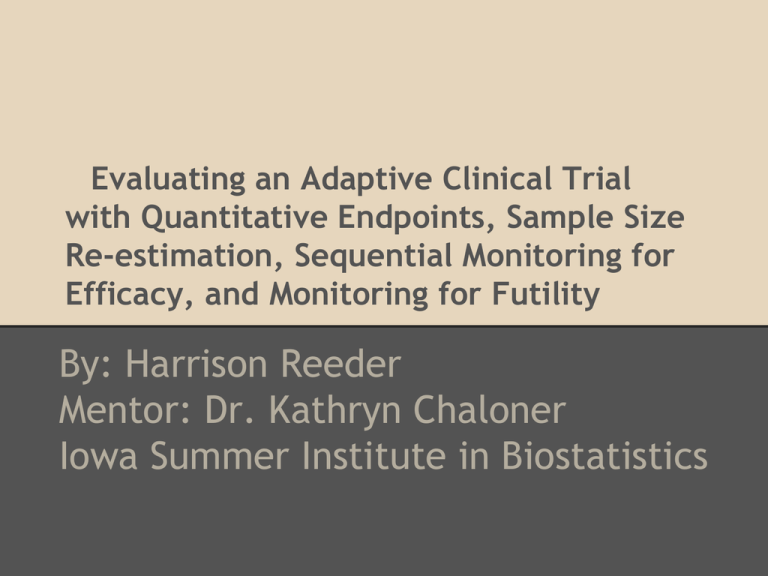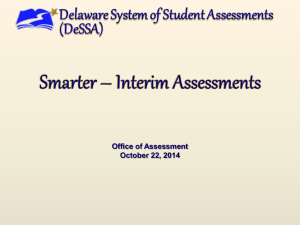Adaptive Clinical Trial Slides
advertisement

Evaluating an Adaptive Clinical Trial with Quantitative Endpoints, Sample Size Re-estimation, Sequential Monitoring for Efficacy, and Monitoring for Futility By: Harrison Reeder Mentor: Dr. Kathryn Chaloner Iowa Summer Institute in Biostatistics Outline • What exactly does that title mean? Basic Clinical Trial design o Interim Monitoring for Efficacy 3 schemes for interim monitoring for efficacy o Interim monitoring for futility o Adaptive sample size re-estimation o • • Simulation Study of Design Performance Conclusion Clinical Trial Design: The Basic Case • • The most basic element of clinical trial design is determining an adequate sample size Calculating sample size requires specifying: • • • • approximate variance of outcomes the desired Type I error rate minimum clinically meaningful treatment effect desired power to detect that effect Code in R: power.t.test() Taken from Introduction to Randomized Controlled Clinical Trials by John Matthews Motivating Clinical Trial Example • Treatment of insomnia in children with autism o Phase II Clinical Trial • Only previous study was small and on adult subjects • In general, poor understanding of responses motivates need for adaptive trial o Better performance with incorrect estimates? Interim Monitoring for Efficacy • • Why use interim monitoring? Complications of interim monitoring Interim monitoring inflates Type I error Solution: Change boundary of significance Taken from Introduction to Randomized Controlled Clinical Trials by John Matthews Schemes for Interim Efficacy Monitoring • Pocock "constant" boundaries o • o O'Brien-Fleming boundaries o • sets constant p-value boundary to use at every monitoring point Earlier rejection is easier, but final test is stringent makes rejection harder at earlier points and easier as trial progresses Fleming-Harrington-O'Brien boundaries o middle-ground between above strategies Boundary First Interim Second Interim Third Interim Final point Pocock 0.0182 0.0182 0.0182 0.0182 O-F 0.00005 0.0039 0.0184 0.0412 F-H-O 0.0067 0.0083 0.0103 0.0403 Interim Monitoring for Futility • • Why monitor for futility? Conditional power Estimates probability of having significant results given observed data and (design) assumptions o If probability is lower than a specified threshold, then trial is stopped o Adaptive Sample Size Recalculation • Early estimate of response variance is • • difficult To account for difference between estimate and true value, this design uses observed estimated variance halfway into trial to re-estimate sample size Investigators can set a maximum sample size for each group Research Question: How does our design perform? • Using simulation, we compare the design to designs without the features described o • We also compare the merits of the three interim monitoring schemes Values of interest: Bias of final treatment effect estimate o True confidence of nominal 95% Confidence Interval o True Type I error o True power o Distribution of stopping points o Designing the Simulation First Interim Second Interim • Sample Size is 9 • Check for efficacy • • • • Sample Size is 18 Check for efficacy Check for futility Final sample size is recalculated • Sample size is Third Interim 𝐹𝑖𝑛𝑎𝑙+18 2 if recalculated • Without sample size recalculation, size is 28 • Check for efficacy Motivating Study: Effect of Sleeping Drug in Adolescents and Young Adults with Autism Spectrum Disorder Design assumptions: • • Mean treatment effect: 32 Response standard deviation: 36 • Sample size is Final ≤ 50 if recalculated • Without sample size recalculation, size is 35 Final Point • Check for efficacy Simulation seed: 42 Conditional power seed: 123 Comparison of Boundary Types • Pocock Highest Type I error o Highest bias o Lowest power o Smallest sample size (i.e., best chance of finding efficacy early) o • O'Brien-Fleming and Fleming-Harrington-O'Brien o Similar results across measures and assumptions O'Brien-Fleming boundary is more commonly used Effect of Interim Monitoring for Efficacy (Without Sample Size Re-estimation or Futility Monitoring) • Ending sample size < 35 per group because we can stop at earlier interim points when results are significant Effects of Interim Monitoring for Futility (Without Sample Size Re-estimation) • • Large drop in true Type I error from ~0.05 to ~0.01 (more opportunities to stop an ineffective trial from following through to the end and having significance by chance) Smaller stopping point sample size when response variance is larger than expected o Chance of stopping early for futility, even if alternative is true, explains a slight drop in true power Effects of Interim Monitoring for Futility (Without Sample Size Re-estimation) Effects of Sample Size Recalculation • If initial estimate of treatment response variance was too high, recalculation tends to decrease the ending sample size Likewise, underestimated variance leads to a larger required sample size Recalculation also maintains power of trial better even when initial estimate of variance is too low o • Effects of Sample Size Re-estimation (Without Futility Monitoring) Overall Evaluation of Our Design These characteristics show the design's potential value in Phase II trials: Minimizes Type I error rate Maintains power when variance estimate is too low May decrease sample size required to reach a conclusion Limitations: Sample size re-estimation potentially increases cost • • • • How Does Our Design Compare to Interim Monitoring for Efficacy Alone? • If assumptions are accurate, with our design: Median ending sample size is smaller o Power is slightly lower, but comparable o Type I error rate is lower (important for Phase 2 trials) o • If assumptions are inaccurate (overestimated effect size and underestimated variance): o o o Ending sample size tends to be larger (more expensive) Power is higher (though overall both are much lower) Type I error rate is lower O'Brien-Fleming Graphs Conclusion: "Is our design better for the motivating study?" Yes! Minimizing Type I errors is important in Phase II trials, which is achieved in our design Treatment effect and response variance are not easily estimated in the motivating study • • o Our design's ability to maintain power and keep error rates low even with inaccurate design assumptions is beneficial Limitation: Potential for higher re-estimated sample size may increase cost of trial • Acknowledgements • The Iowa Summer Institute for Biostatistics • • • program Dr. Kathryn Chaloner and the entire University of Iowa Biostatistics department My research partner Kamrine Poels at the University of Arizona The Carleton Math Department






